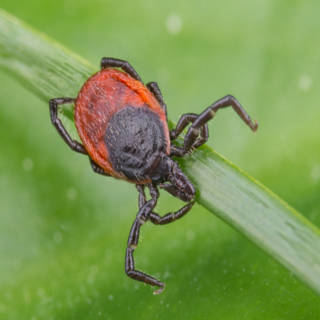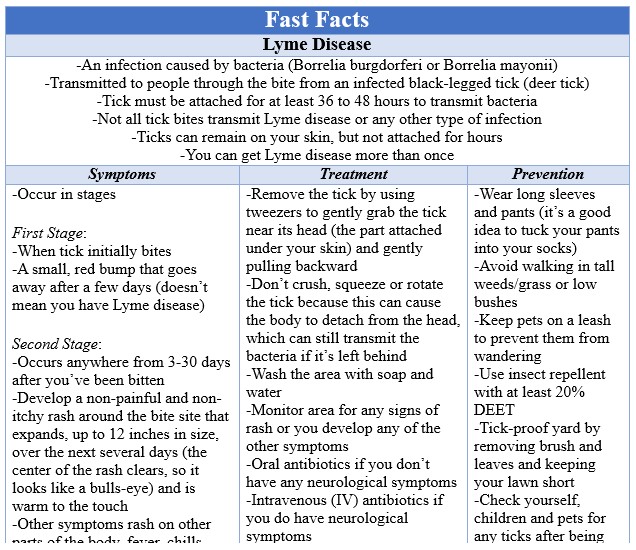What is it?
You’ve spent the day outside enjoying the beautiful summer weather. Unfortunately, after coming inside, you notice that you’ve got a tick latched on to one of your ankles. You remove it, but notice that you still have a small, red bump. What does this mean? Do you have Lyme disease? What are the symptoms? How is it treated? Can you prevent it?
 Definition
Definition
Lyme disease is an infection that is caused by bacteria. Here in the United States, it’s caused by either Borrelia burgdorferi or Borrelia mayonii. The bacterium is transmitted to people most often through the bite from an infected black-legged tick, or deer tick. In order to transmit the infection to a person, usually the tick must be attached for at least 36 to 48 hours. You can tell how long a tick has been attached based off of their size. Normally, ticks are incredibly small, but if they’ve been feeding for a while, they look swollen. It’s important to note that not all tick bites transmit Lyme disease or any other type of infection, but the likelihood of it happening increase the longer it’s attached. Another important thing to consider is that ticks can remain on your skin, but not attached for hours.
The symptoms Lyme disease occur in stages. The first stage is when the tick initially bites you and remains attached or you remove it. Afterwards, you’ll notice a small, red bump that goes away after a few days. All tick bites appear this way, so this doesn’t necessarily mean you have Lyme disease, just that you’ve been bitten by a tick. The next stage occurs anywhere from 3-30 days after you’ve been bitten. During this stage, you develop a rash around the bite site. This rash expands, up to 12 inches in size, over the next several days. Sometimes, the center of the rash clears, so it looks like a bulls-eye. The rash isn’t usually painful or itchy, but warm to the touch. This the most recognized symptom of Lyme disease, but not everyone experiences it. Also, some people might develop the rash on other parts of their body as well. In addition to the rash, you can have fever, chills, body aches, headache, neck stiffness and swollen lymph nodes. If you don’t seek treatment after having any of these symptoms, you might have a return of the rash on your body, joint pain or neurological problems, like meningitis, muscle weakness, or temporary paralysis of your face, in the weeks to months following the bite.
Treatment
The good news is that since Lyme disease is caused by bacteria, antibiotics are effective at treating it. The first step after experiencing a tick bite is to remove the tick because this will greatly reduce your chances of contracting Lyme disease. You do this by using tweezers to gently grab the tick near its head (the part attached under your skin) and gently pulling backward. Be sure not to crush, squeeze or rotate the tick because this can cause the body to detach from the head, which can still transmit the bacteria if it’s left behind. After removing the tick, be sure to wash the area well with soap and water. Over the next few days/weeks, monitor the area for any signs of rash or you develop any of the other symptoms. If you do, you should see your doctor right away. Most often, your doctor will be able to prescribe you antibiotic pills that you can take at home over the next 14 to 21 days. It’s essential that you take all of them in order to prevent any of the complications from occurring. If you’re having any neurological symptoms from the infection, you doctor will prescribe intravenous (IV) antibiotics for the next 14 to 28 days. Some individuals still have symptoms even after taking antibiotics. This is called post-Lyme disease syndrome and the reason for this is unknown. Unfortunately, taking more antibiotics doesn’t make them go away, but they do go away on their own over time.
Prevention
The best way to prevent Lyme disease is by knowing where ticks live and being prepared. Deer ticks live in heavily wooded areas of the Northeast and Midwest. In order to protect yourself, children and pets, there are several things that you can do. The first is to wear long sleeves and pants (it’s a good idea to tuck your pants into your socks). Avoid walking in tall weeds/grass or low bushes because this is where ticks like to live. Also, keep your pets on a leash to prevent them from wandering into these areas. Using insect repellent with at least 20% DEET is helpful. Tick-proofing your yard is essential in order to eliminate areas where they like to live. You can do this by removing brush and leaves and keeping your lawn short. When you come inside, be sure to check yourself, children and pets for any ticks. Since ticks are so small, it can be very hard to see them, so make sure to take your time. It’s a good idea to shower soon after coming inside since any ticks might not have attached yet. Even if you have had Lyme disease before, you can still get it again, so always take every precaution that you go outside.
Finding a tick on your body can be a scary feeling, but not all of them carry Lyme disease. If you do end up with it, remember it’s treatable. If you have any questions or concerns about Lyme disease, please speak with your doctor. If you would like more information, please visit the Center for Disease Control (CDC) Lyme disease page at https://www.cdc.gov/lyme/index.html